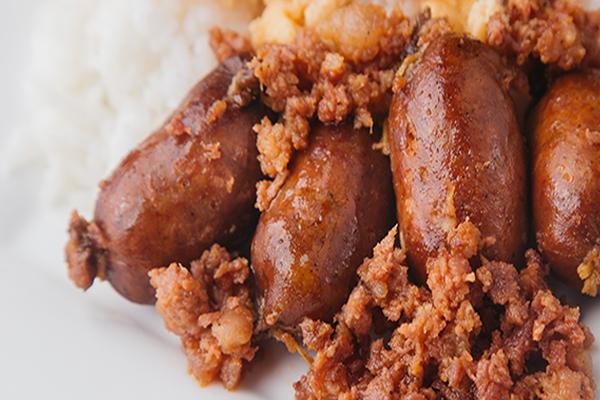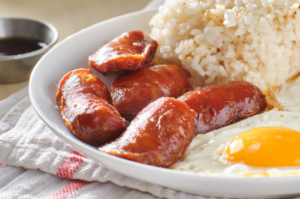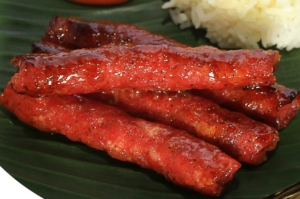
About Us
Jocyl's Food Products (a.k.a "Chorizo de Kalibo") is a bold and forward-thinking company whose goals are set to create surprising ways of developing and promoting our products. We are entrepreneurial and visionary in producing and marketing the best chorizo and other food products from our hometown - Kalibo, Aklan, Philippines.
About UsContact Info
- Tigayon Highway, Barangay Tigayon, Kalibo, Aklan
- +63362628688
- jocylsfoods@gmail.com
- Tigayon Highway, Barangay Tigayon, Kalibo, Aklan
- jocylsfoods@gmail.com
- +63362628688

Mouthwatering Secrets: Longganisa History and Origin Explained
-
Jocyl's Food Products > Blog > Chicken > Mouthwatering Secrets: Longganisa History and Origin Explained
Introduction:
Longganisa, a popular Filipino sausage, earns renown for its savory and distinct flavor. But have you ever wondered about the fascinating history and origin behind this delectable delicacy? In this article, we delve into the mouthwatering secrets of longganisa, tracing its roots and exploring its journey to becoming a beloved culinary icon in the Philippines. Join us as we uncover the rich history and origin of longganisa, taking you on a flavorful journey through time.
I. The Origins of Longganisa
Longganisa, the succulent Filipino sausage, has a captivating history that dates back centuries. To understand its origins, we must explore the early influences on Philippine cuisine, the significant Spanish influence that led to its creation, and the diverse regional variations that contribute to the array of longganisa styles enjoyed today.
A. Early Influences on Philippine Cuisine
Philippine cuisine is a tapestry woven from a multitude of cultural influences. Before the arrival of foreign colonizers, indigenous Philippine tribes had already established a rich culinary heritage based on locally available ingredients. These early influences included the use of aromatic herbs, indigenous spices, and unique cooking techniques that laid the foundation for the country’s diverse culinary landscape.
B. Spanish Influence: The Birth of Longganisa
The introduction of Spanish cuisine during the 16th century brought about a significant transformation in Philippine cooking. Spanish colonizers, eager to recreate the flavors of their homeland, introduced various ingredients and culinary techniques to the archipelago. It was during this period that longganisa was born.
Longganisa owes its existence to the Spanish chorizo, a cured sausage commonly found in Spanish cuisine. The Spanish chorizo underwent adaptation and localization as it merged with the flavors and ingredients of the Philippines. They incorporated local spices, including garlic, vinegar, and an array of aromatic herbs, into the recipe, resulting in the distinct flavor profile that sets longganisa apart.
C. Regional Variations: Diversity in Longganisa Styles
Across the different regions of the Philippines, longganisa has developed unique regional variations, each with its own flavor profile and cooking methods. This regional diversity is a testament to the country’s rich culinary heritage and the creativity of local communities.
In Vigan, a city in the northern part of the Philippines, Vigan longganisa takes center stage. Known for its garlicky and tangy taste, Vigan longganisa is made from ground pork mixed with local vinegar and native spices. This particular variety is famous for its long and thin shape.
On the other hand, Lucban longganisa hails from the province of Quezon. It features a distinct blend of flavors, combining sweet, savory, and tangy notes. People often make Lucban longganisa with a mixture of ground pork and ground fatback, seasoning it with garlic, black pepper, and vinegar. During the annual Pahiyas Festival, it is commonly enjoyed and takes center stage in various traditional dishes.
In Cebu, a province in the Visayas region, Cebu longganisa showcases a unique balance of sweet and spicy flavors. Made with ground pork, garlic, native vinegar, and a touch of sugar, it creates a delightful combination that tantalizes the taste buds. People often enjoy Cebu longganisa with rice, eggs, and a side of vinegar.
These regional variations exemplify the diversity and ingenuity of Filipino cuisine. Each style of longganisa reflects the local flavors, cultural influences, and culinary traditions that have been passed down through generations.
By understanding the origins of longganisa and the regional variations that exist, we gain a deeper appreciation for this beloved Filipino sausage. The story of longganisa continues to evolve, intertwining history, culture, and flavors to create a culinary legacy that is truly mouthwatering.
II. The Evolution of Longganisa
Longganisa has evolved over time, adapting to changing tastes and cultural influences. In this section, we explore the traditional preparation techniques that have shaped longganisa, the key ingredients that define its unique flavor, and the impact of cultural exchange on this beloved Filipino sausage.
A. Traditional Preparation Techniques
Longganisa is traditionally prepared using age-old techniques that have been passed down through generations. The process begins with selecting the finest cuts of pork, typically from the shoulder or belly, and grinding them to achieve the desired texture. The ground pork is then mixed with a combination of seasonings, such as garlic, salt, pepper, and local spices, to infuse it with rich flavors.
After seasoning the meat, carefully stuff it into casings made from natural materials, such as hog or sheep intestines. Twist or tie the casings at regular intervals to create individual sausages. This step is crucial in giving longganisa its characteristic shape and texture.
Once you form the sausages, let them cure or marinate for a certain period to allow the flavors to meld together. Some varieties of longganisa air-dry, while others smoke or cook immediately after preparation. These traditional preparation techniques contribute to the unique taste and texture that make longganisa so irresistible.
B. Ingredients that Define Longganisa
The distinct flavor profile of longganisa is defined by the careful selection of ingredients. While the exact combination varies across different regional styles, there are several key components that commonly feature in longganisa recipes.
Garlic, with its aromatic and pungent qualities, is an essential ingredient in most longganisa variations. It adds depth of flavor and enhances the overall taste of the sausage. Vinegar, whether distilled or native, is another crucial ingredient that provides tanginess and acts as a natural preservative.
Native spices, such as black pepper, paprika, annatto, and bay leaves, are often used to season longganisa, giving it a distinctive and complex flavor profile. These spices add warmth, earthiness, and a touch of sweetness to the sausage.
Apart from the seasonings, the quality and type of pork used in longganisa play a significant role in its taste. The right balance of lean meat and fat is crucial to achieving the desired texture and succulence. Local farmers take pride in raising pigs that produce high-quality pork, ensuring that longganisa is made with the finest ingredients.
C. Impact of Cultural Exchange on Longganisa
Longganisa’s evolution is not solely rooted in local traditions. Throughout history, the Philippines has been a melting pot of cultures, resulting in a rich tapestry of culinary influences. Various waves of cultural exchange, including Spanish, Chinese, and American influences, have left their mark on the development of longganisa.
Spanish colonization introduced new ingredients and cooking techniques, shaping the early versions of longganisa. Chinese immigrants, known for their culinary expertise, contributed their knowledge of spices and flavor combinations, further enhancing the diversity of longganisa styles. In more recent times, American influences have introduced new flavors and cooking methods, leading to innovative interpretations of longganisa.
These cultural exchanges have not only influenced the ingredients and techniques used in longganisa but have also contributed to its popularity and recognition both locally and globally. Longganisa has become a symbol of the Philippines’ multicultural heritage and its ability to embrace and adapt to different culinary traditions.
Understanding the evolution of longganisa provides us with a deeper appreciation for its flavors and cultural significance. The combination of traditional techniques, carefully selected ingredients, and the impact of cultural exchange has shaped longganisa into the mouthwatering delicacy it is today.
III. Longganisa: A Culinary Treasure
Longganisa holds a special place in Filipino cuisine, representing more than just a delicious sausage. In this section, we explore how longganisa is deeply intertwined with Filipino breakfast culture, its vibrant presence in local festivals, and its significance as a symbol of Filipino identity.
A. Longganisa and Filipino Breakfast Culture
Longganisa is a breakfast staple in Filipino households, gracing tables with its tantalizing aroma and rich flavors. It has become an integral part of the Filipino breakfast experience, offering a hearty and satisfying start to the day.
Traditionally, longganisa is served with garlic fried rice, sunny-side-up eggs, and a side of vinegar for dipping. The combination of flavors and textures creates a harmonious symphony that is both comforting and indulgent. The succulent and savory profile of longganisa perfectly complements the fragrant garlic rice and the richness of the eggs, resulting in a breakfast ensemble that is beloved by Filipinos of all ages.
Longganisa not only provides nourishment but also fosters a sense of community and togetherness. It is often shared among family members, creating a warm and convivial atmosphere during breakfast gatherings. This cultural practice highlights the importance of food in Filipino culture, where meals are not merely sustenance but an opportunity for connection and celebration.
B. Longganisa Festivals: Celebrating the Sausage
Longganisa’s cultural significance goes beyond the confines of the dining table. Throughout the Philippines, numerous festivals celebrate the beloved sausage, paying homage to its flavors and heritage.
One such festival is the Longganisa Festival in Vigan, Ilocos Sur. This vibrant event showcases the local Vigan longganisa and its historical significance. Visitors can indulge in a feast of various longganisa styles, witness colorful parades, and participate in cooking competitions that highlight the artistry behind this culinary treasure.
Other regions, such as Lucban in Quezon province, also host their own longganisa festivals. Experience the vibrant Pahiyas Festival celebrating harvests, adorned with colorful rice-based decorations. Lucban longganisa shines as locals showcase mouthwatering dishes and culinary exhibitions during this joyous event.
These festivals not only celebrate the flavors and traditions of longganisa but also serve as opportunities for communities to come together, showcase their cultural heritage, and attract visitors from all over the world. Longganisa becomes a unifying symbol, connecting people through their shared love for food and Filipino traditions.
C. Longganisa as a Symbol of Filipino Identity
Longganisa symbolizes Filipino identity, holding a special place in their hearts. It reflects the diversity and resilience of Filipino culture, influenced by various sources, embodying its richness.
As Filipinos carry their culinary traditions wherever they go, longganisa becomes a taste of home for those living abroad. It serves as a reminder of their roots and a way to preserve their cultural heritage. Longganisa is a source of comfort, nostalgia, and pride, bringing people together and forging connections that transcend geographical boundaries.
Moreover, longganisa serves as a testament to the resourcefulness and creativity of Filipinos. From the adaptation of Spanish chorizo to the development of regional variations, longganisa exemplifies the Filipino knack for transforming ingredients into something uniquely their own. It represents the ability to innovate and create something extraordinary out of simple and humble ingredients.
In essence, longganisa is more than just a sausage. It is a reflection of the Filipino spirit, a symbol of community, and a testament to the diverse and vibrant culinary landscape of the Philippines. It embodies the flavors, traditions, and shared experiences that shape Filipino identity both at home and abroad.
IV. Popular Varieties of Longganisa
Longganisa comes in a delightful array of regional variations, each with its own distinct flavors and characteristics. In this section, we explore three popular varieties of longganisa: Vigan Longganisa, Lucban Longganisa, and Cebu Longganisa. These mouthwatering sausages offer unique culinary experiences, showcasing the diversity and creativity of Filipino cuisine.
A. Vigan Longganisa: A Taste of Heritage
Vigan Longganisa is a culinary treasure that originates from the historic city of Vigan in the northern part of the Philippines. It is a taste of heritage, capturing the essence of the region’s culinary traditions.
Vigan Longganisa is known for its garlicky and tangy flavor profile. The combination of ground pork, garlic, vinegar, and local spices creates a savory sensation that is both satisfying and distinct. What sets Vigan Longganisa apart is its long and thin shape, showcasing the meticulous craftsmanship that goes into its preparation.
When cooked, Vigan Longganisa fills the air with its mouthwatering aroma, beckoning all to indulge in its flavors. Whether enjoyed for breakfast, lunch, or dinner, Vigan Longganisa is a beloved culinary delight that pays homage to the city’s rich cultural heritage.
B. Lucban Longganisa: A Festive Delight
Lucban Longganisa takes center stage during the annual Pahiyas Festival, held in the town of Lucban in Quezon province. This festive delight is a celebration of flavor, color, and tradition.
What sets Lucban Longganisa apart is its unique blend of sweet, savory, and tangy flavors. Made from a mixture of ground pork, garlic, black pepper, and vinegar, it offers a tantalizing taste experience that tickles the taste buds. The combination of spices creates a delightful balance that complements a variety of dishes.
Pahiyas Festival highlights Lucban Longganisa in traditional dishes, showcasing local culinary artistry. From crispy bites to hearty stews, this festive sausage brings flavor and joy to the celebration.
C. Cebu Longganisa: Sweet and Spicy Pleasure
Cebu Longganisa hails from the vibrant province of Cebu in the Visayas region, offering a delightful blend of sweet and spicy flavors. This variety of longganisa is a pleasurable indulgence that captures the essence of Cebuano cuisine.
Cebu Longganisa is made from ground pork, garlic, native vinegar, and a hint of sugar. The combination of these ingredients creates a unique flavor profile that balances the sweetness and spiciness, resulting in a satisfying sensory experience. The slightly sweet undertones perfectly complement the savory notes, creating a harmony of flavors that is truly enjoyable.
Whether grilled, fried, or incorporated into various dishes, Cebu Longganisa brings a burst of flavor to any meal. Its distinct taste has gained popularity not only within the Philippines but also among food enthusiasts worldwide, making it a true culinary pleasure.
These popular varieties of longganisa showcase the rich diversity of Filipino cuisine and the regional influences that shape each unique style. From the heritage of Vigan Longganisa to the festive traditions of Lucban Longganisa and the sweet-spicy pleasure of Cebu Longganisa, these sausages offer a delectable exploration of flavors, enticing both locals and visitors alike. Experience the distinct taste of each variety and embark on a flavorful journey through the diverse longganisa landscape of the Philippines.
V. Longganisa Beyond Borders
Longganisa has transcended its Filipino roots and gained recognition and popularity beyond the borders of the Philippines. In this section, we explore how longganisa has found its way into Filipino diaspora communities, its rising global appeal, and its incorporation into international cuisine through fusion and adaptations.
A. Longganisa in Filipino Diaspora Communities
As Filipinos have migrated and established communities around the world, they have brought their culinary traditions with them. Longganisa holds a special place in the hearts of Filipino diaspora communities, serving as a flavorful connection to their cultural heritage.
Filipino stores and restaurants in the United States, Canada, and Australia cater to cravings of the diaspora, serving familiar dishes like longganisa. Imported or locally made, these communities preserve culinary traditions for generations.
Longganisa has become a way for Filipino diaspora communities to share their culture with others, inviting friends and neighbors to experience the unique flavors and traditions of the Philippines. It serves as a delicious bridge that brings people together and fosters a sense of belonging in foreign lands.
B. Longganisa’s Rising Global Popularity
Beyond Filipino diaspora communities, longganisa is gaining popularity among food enthusiasts worldwide. As global palates become more adventurous and open to exploring diverse cuisines, longganisa has caught the attention of international food lovers.
Food festivals, culinary blogs, and social media platforms have played a significant role in promoting longganisa and introducing it to a wider audience. Its distinctive flavors, succulent texture, and rich history have captivated the curiosity of culinary enthusiasts and adventurous eaters alike.
Longganisa’s rising global popularity can also be attributed to the growing interest in exploring lesser-known and authentic regional cuisines. Food travelers and explorers seek out unique and traditional dishes, and longganisa perfectly fits the bill. Its combination of flavors, cultural significance, and the story behind its creation make it an intriguing and memorable addition to any culinary journey.
C. Fusion and Adaptations: Longganisa in International Cuisine
Longganisa’s versatility and distinctive taste have inspired culinary creatives to incorporate it into international cuisine, resulting in fusion dishes and adaptations that offer exciting flavor combinations.
In the realm of fusion cuisine, longganisa has found its way into dishes like longganisa tacos, longganisa burgers, and longganisa pasta. These innovative creations blend the familiar flavors of longganisa with elements from other culinary traditions, creating a fusion of tastes that cater to evolving palates.
Moreover, longganisa has served as a source of inspiration for chefs and home cooks alike when experimenting with traditional recipes. It has adapted to suit different cultural preferences and dietary requirements, resulting in exciting variations such as chicken longganisa, vegetarian longganisa, and healthier options that cater to specific dietary needs.
Longganisa’s fusion and adaptations showcase versatility and culinary enthusiasts’ willingness to experiment. Incorporating it into international cuisine introduces unique Filipino flavors and highlights adaptability and creativity in Filipino cooking.
Longganisa’s journey beyond borders has brought it into the global culinary spotlight. As it continues to captivate taste buds around the world, longganisa serves as a delicious ambassador of Filipino culture, connecting people through their love for flavorful and diverse cuisine.
VI. Longganisa: A Recipe Worth Trying
Indulge in the delight of longganisa, a culinary adventure you can embark on. Discover a step-by-step guide, mouthwatering recipes, and innovative ways to incorporate longganisa into your cooking.
A. Step-by-Step Guide: Making Traditional Longganisa
Creating your own batch of traditional longganisa allows you to experience the authentic flavors and craftsmanship that go into this beloved sausage. Here is a step-by-step guide to making your very own longganisa:
- Gather the ingredients: You’ll need ground pork, garlic, vinegar, soy sauce, sugar, black pepper, salt, and natural casings for stuffing the mixture.
- Prepare the mixture: In a large bowl, combine the ground pork, minced garlic, vinegar, soy sauce, sugar, black pepper, and salt. Mix well until the ingredients are evenly distributed.
- Stuff the casings: Attach a sausage stuffer to a natural casing, and carefully feed the pork mixture into the casing, ensuring it is evenly filled. Twist the casing at regular intervals to create individual longganisa links.
- Cure the longganisa: Hang the longganisa in a cool, well-ventilated area for a few hours or overnight to allow the flavors to develop. Alternatively, refrigerate the longganisa for a day or two to let the flavors meld together.
- Cook and enjoy: Longganisa can be cooked in various ways such as grilling, frying, or baking. Whichever method you choose, make sure the longganisa is cooked through and has a golden brown color. Serve hot and enjoy the delicious flavors of your homemade longganisa.
B. Delicious Dishes with Longganisa
Longganisa’s versatility extends beyond being a standalone dish. It can be used to elevate a wide range of culinary creations. Here are some mouthwatering dishes that showcase the delectable flavors of longganisa:
- Longganisa Fried Rice: Sauté chopped longganisa with garlic, onions, and rice for a flavorful and satisfying one-pot meal.
- Longganisa Breakfast Burrito: Wrap scrambled eggs, sautéed vegetables, cheese, and chopped longganisa in a tortilla for a hearty and portable breakfast option.
- Longganisa Pasta: Toss cooked pasta with a sauce made from diced tomatoes, garlic, onions, and crumbled longganisa for a delightful fusion of Italian and Filipino flavors.
- Longganisa Bao Buns: Fill fluffy steamed buns with pan-fried longganisa, pickled vegetables, and a drizzle of sweet and tangy sauce for an Asian-inspired twist.
- Longganisa Pizza: Top your favorite pizza dough with tomato sauce, mozzarella cheese, sliced longganisa, and a sprinkle of herbs for a unique and mouthwatering pizza experience.
C. Exploring Culinary Innovations with Longganisa
Longganisa’s adaptability lends itself to culinary innovations and creative flavor combinations. Here are some ideas to explore and expand your culinary repertoire:
- Longganisa-Stuffed Bell Peppers: Hollow out bell peppers, stuff them with a mixture of cooked longganisa, rice, vegetables, and cheese, and bake them until tender for a flavorful and colorful meal.
- Longganisa Hash: Sauté diced longganisa with potatoes, onions, and bell peppers until crispy and golden for a hearty and satisfying breakfast or brunch option.
- Longganisa Spring Rolls: Roll cooked longganisa, fresh vegetables, and herbs in spring roll wrappers, and serve them with a dipping sauce for a delightful appetizer or snack.
- Longganisa Burger Sliders: Shape ground longganisa into small patties, grill or pan-fry them, and serve them on mini buns with your favorite toppings for a fun and flavorful twist on classic sliders.
- Longganisa Empanadas: Fill empanada dough with cooked longganisa, potatoes, peas, and spices, and bake them until golden and crispy for a savory and portable snack.
Unleash culinary creativity with longganisa as your inspiration. Impress loved ones with unique and delicious dishes. Follow the guide, explore delectable recipes, and create flavorful longganisa-inspired masterpieces.
Conclusion:
Longganisa, with its tantalizing flavors and cultural significance, has become an integral part of Filipino cuisine. Its history and origin reveal the diverse influences that have shaped the culinary landscape of the Philippines. From its humble beginnings to its international recognition, longganisa continues to captivate taste buds and bring people together. So, the next time you savor a piece of this mouthwatering sausage, remember the rich tapestry of history and tradition that it represents. Let the secrets of longganisa add a touch of flavor and heritage to your culinary adventures.
Jocyl’s Social Media:
https://www.facebook.com/jocylsfoods
https://www.instagram.com/jocylsfoods
https://www.twitter.com/jocylsfoods
https://www.pinterest.ph/jocylsfoods
https://www.tiktok.com/@jocylsfoodsproducts
Related posts:
Recent Posts
- The Ultimate Guide to Authentic Filipino Breakfast: Why Chorizo de Kalibo Is Taking 2026 to the next level!
- Ultimate Aklan Pasalubong Guide: Authentic Filipino Treasures
- How to Cook Longganisa Without Oil: Easy, Healthy & Delicious Guide
- Ultimate Guide: How to Cook Ilonggo Longganisa – Perfect Every Time!
- What is Ilonggo Food? Discover the Rich Flavors of Western Visayas Cuisine
Recent Comments
Archives
- October 2025
- September 2025
- August 2025
- July 2025
- May 2025
- April 2025
- March 2025
- February 2025
- January 2025
- November 2024
- October 2024
- September 2024
- August 2024
- June 2024
- March 2024
- February 2024
- January 2024
- December 2023
- November 2023
- October 2023
- August 2023
- July 2023
- June 2023
- May 2023
- April 2023
- March 2023
- February 2023
Tags
- Aklan
- Aklan Pasalubong
- Boracay
- Boracay Food
- Boracay Island
- Boracay Pasalubong
- boracay snacks
- Boracay Souvenirs
- Breakfast
- Chicken
- chicken tocino
- Chori Burger
- chorizo
- ChorizoDeKalibo
- chorizo recipe
- Delicacies
- embutido
- embutido recipe
- Filipino Chorizo
- Filipino Cuisine
- filipino food
- Filipino Longganisa
- Filipino Sausage
- foodie guide
- homemade
- Iloilo
- Iloilo Chorizo
- Iloilo Food
- Iloilo Longganisa
- Iloilo Pasalubong
- ingredients
- JocylsFoods
- longaniza
- longganisa
- longganisa recipe
- meat
- Pasalubong
- pinoy recipes
- pork tocino
- recipe
- Recipes
- skinless longganisa
- snacks
- tocino
- tocino recipe








